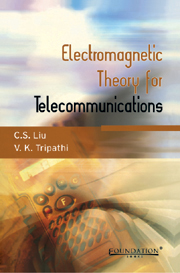Book contents
- Frontmatter
- Contents
- Preface
- 1 Electromagnetic Fields
- 2 Plane Waves
- 3 Guided Waves
- 4 Radiation
- 5 Radio Communication and Radar
- 6 Satellite Communication
- 7 Laser and Optical Fibre Communication
- 8 Geological Seisming and Remote Sensing
- 9 Relativistic Covariance of Electrodynamics
- 10 Radiation from Accelerated Charges
- Appendix A
- Appendix B
- Index
8 - Geological Seisming and Remote Sensing
Published online by Cambridge University Press: 26 October 2011
- Frontmatter
- Contents
- Preface
- 1 Electromagnetic Fields
- 2 Plane Waves
- 3 Guided Waves
- 4 Radiation
- 5 Radio Communication and Radar
- 6 Satellite Communication
- 7 Laser and Optical Fibre Communication
- 8 Geological Seisming and Remote Sensing
- 9 Relativistic Covariance of Electrodynamics
- 10 Radiation from Accelerated Charges
- Appendix A
- Appendix B
- Index
Summary
Introduction
Underground exploration of oil, minerals and other reserves is an area of high practical interest. The technique of magneto-telluric, employing ultra low frequency (ULF) waves, has emerged as a powerful tool in this endeavour. Extremely low frequency (ELF) waves are useful for undersea exploration and submarine communication. The surface of the Earth, its cloud cover and the atmosphere can be sensed through the techniques of remote sensing, where natural emissions are detected at microwave, millimetre wave and shorter wavelengths using polar and geosynchronous satellites. In this unit, we shall study these fascinating techniques in some detail.
Magneto-Telluric Method
In this technique, one uses a dipole antenna above the surface of the Earth, to produce ULF/ELF waves, and measures the ratio of horizontal components of electric field E to magnetic field H of the wave (called wave impedance Z = E/H) on the surface of the Earth at different locations. This ratio depends on the conductivity of the Earth, σ, upto a depth δ ≃ c(2 ∈0/σω)1/2 where ω is the frequency of the wave, ∈0 is the free space permittivity and c is the velocity of Geological Seisming and Remote Sensing light in free space. By scanning Z with ω, one essentially scans σ with depth (below the surface of the Earth). As one observes Z as a function of horizontal distance on the surface of Earth, anomalies in Z are indicative of the buried ores inside the Earth, just below the location of deviation. For this purpose, one could utilise the naturally occurring electromagnetic disturbance as well.
- Type
- Chapter
- Information
- Electromagnetic Theory for Telecommunications , pp. 244 - 260Publisher: Foundation BooksPrint publication year: 2007

